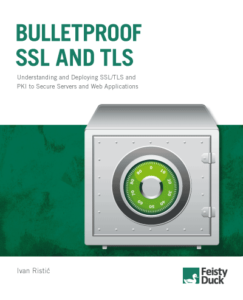Bulletproof SSL and TLS
 As I’m currently involved with lots of openssl automation at work, I bought the book “Bulletproof SSL and TLS” from Ivan Ristić. See the book’s site at https://www.feistyduck.com/books/bulletproof-ssl-and-tls/. Attention, it looks like on Amazon there is only the 2014 edition available, while on Ivan’s blog (https://blog.ivanristic.com/2017/07/announcing-bulletproof-ssl-and-tls-2017-revision.html), which I found out after the purchase of course, there is a 2017 version mentioned. Nevertheless that the book edition I read was a bit dated, I learned a lot, despite having been engaged with openssl before.
As I’m currently involved with lots of openssl automation at work, I bought the book “Bulletproof SSL and TLS” from Ivan Ristić. See the book’s site at https://www.feistyduck.com/books/bulletproof-ssl-and-tls/. Attention, it looks like on Amazon there is only the 2014 edition available, while on Ivan’s blog (https://blog.ivanristic.com/2017/07/announcing-bulletproof-ssl-and-tls-2017-revision.html), which I found out after the purchase of course, there is a 2017 version mentioned. Nevertheless that the book edition I read was a bit dated, I learned a lot, despite having been engaged with openssl before.
It is a difference being able to generate and sign some certificates and knowing the history, the vulnerabilities and mechanisms of the protocol itself. This book is definitively the “bible” of TLS from the founder of the (Qualys) SSL Labs with the famous SSL server test tool (btw. also available as standalone tool: ssllabs-scan on github). So there is quite some expertise and mastership behind this book.
What can one learn from the book? Well first a thorough basis and the insight, or maybe reminder, that TLS is not just encryption but also certificate-based authentication and provides integrity and session management. So it’s a bundle of security functionality that can be used not only for HTTPS but also any other protocol that you can run over TCP. There are many articles about TLS port forwarding, but with the book, I have finally gotten the differences.
There is by the way also a github repository to the book that contains among other resources configuration files for setting up a own root CA for self-signed certificates. That being a task that I’m just involved in and this thus very handy to verify my configuration taken from other sources in the web. Clearly for public customer or browser-facing endpoints one will always have to use purchased certificates from a public CA. But in the innards of a system, behind a reverse proxy or from the application backend to a infrastructure service, such as RabbitMQ or a DB, self-signed certificates, well-configured, serve well their purpose. And you save money and have the full control over expiration time and what not.
Especially interesting for were the details on OSCP and OSCP stapling and all the other initiatives that there are. Certainly a topic that one would like to explore at work for getting an additional grain of security into especially cloud-hosted services. Another concept that was covered were the different ways of pinning and what it really means. It is not so a sophisticated concept that nobody uses, anyhow.
What I found especially helpful were, beyond some openssl command-line examples also a in-depth chapter on configuring Nginx with TLS, something that I happen to just do at the moment at work, too. What a coincidence. That adds well to the Nginx TLS documentation, which is more reference than tutorial. Especially the securing of a down-stream connection to backend services in a reverse proxy scenario.
Well, this is thick book and it took a while to get through but it was worth it and I’m now feeling much better prepared for practical work with TLS, openssl and juggling with certificates.
Yours, Peter